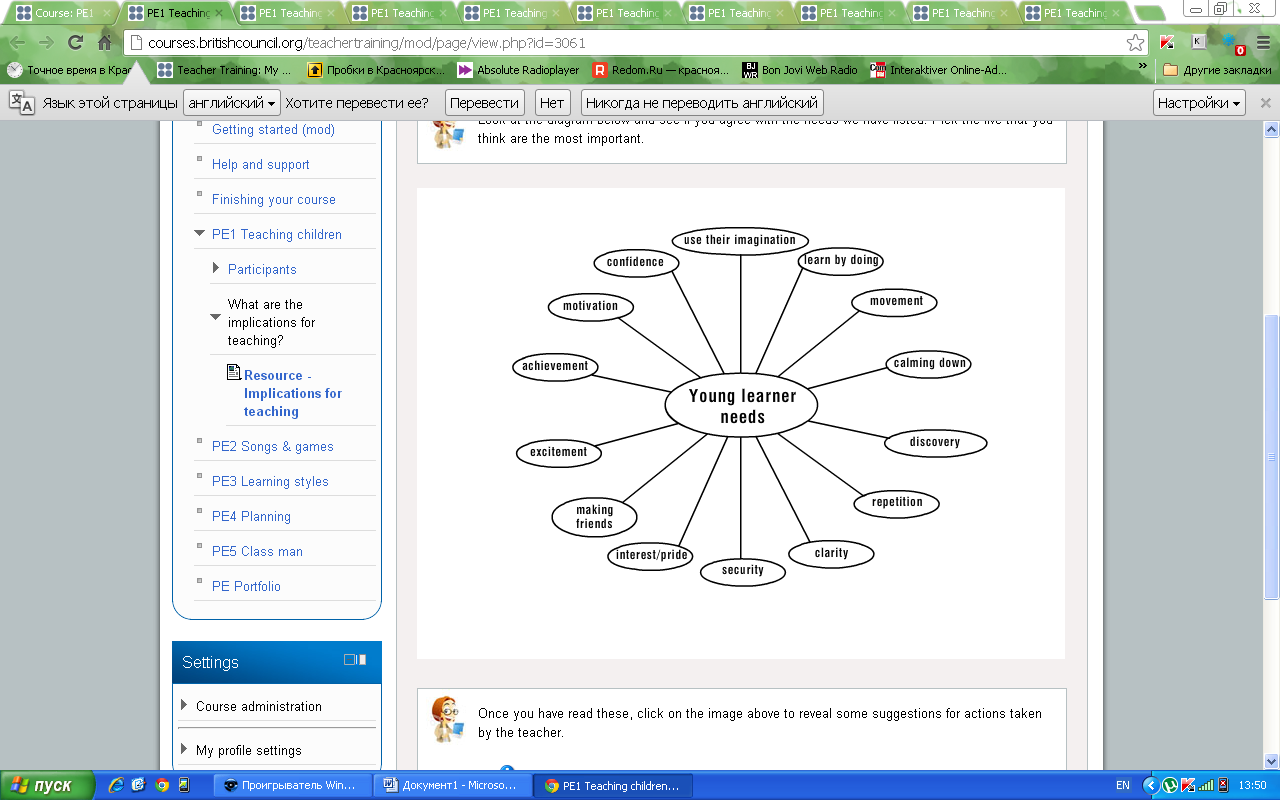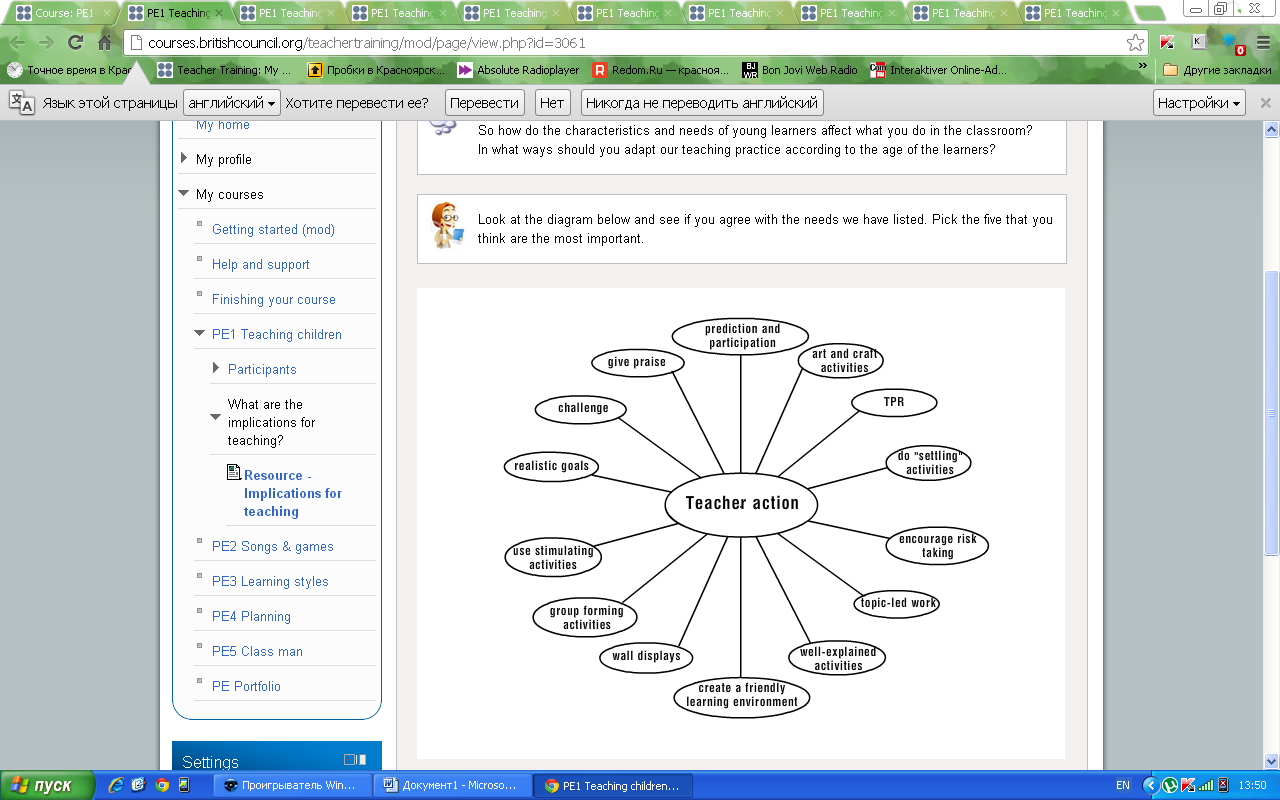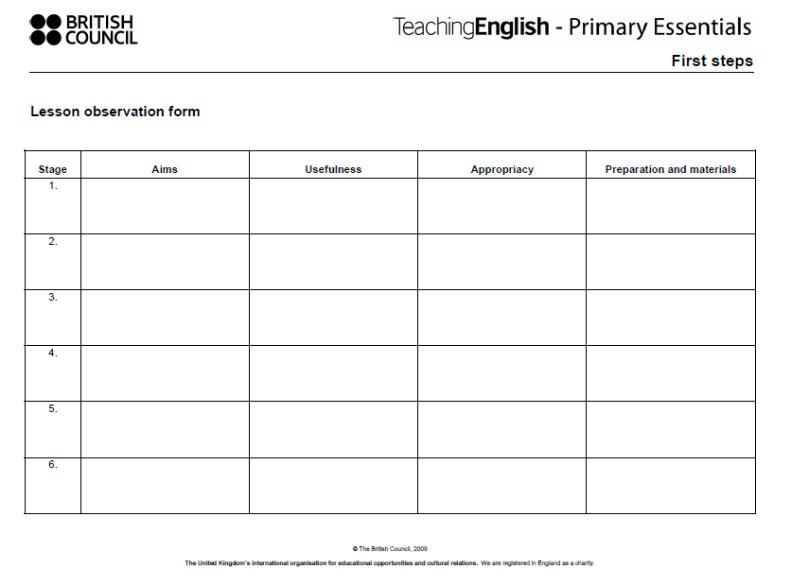
- •1.1 Teaching children
- •2.1 Teaching a second language to young learners
- •2.3 Approaches to English teaching at primary level
- •Formal/traditional comment #1
- •Formal/traditional comment #2
- •Formal/traditional comment #3
- •3.1 What does the young learner need?
- •3.1 Commentary - What does the young learner need?
- •4.1 How do young learners learn?
- •Simon says
- •"This is the way we ..."
- •6.2 First lessons - Expectations
- •6.2 First lessons - Icebreakers
- •6.2 First lesson ideas
- •6.2 Commentary - First lesson ideas
- •6.2 First lesson observation
We have to address this because they need to feel part of a group. Learning in a group, where individuals are expected to act and interact with each other, brings a variety of pressures. Wherever possible we must try to remove any barriers to effective group working. We should aim to foster a more relaxed and accessible learning environment which supports the learning process and encourages a wider sharing and exchange of ideas. One way that you can do this is to use activities which help with the group forming process and create a supportive learning community. These group-formation activities allow children to gain confidence, take risks and encourage friendships and fun: all of which are important in our 'ideal' language classroom. Many of the activities that we look at on this course will have a group-forming aspect to them.
4.1 How do young learners learn?
Look at the table below. It shows some of the differences between the child and the teenager and allows you to see some of the areas where you can focus.
Child |
Pre-teen |
Teenager |
Learns most by doing things |
Becoming aware of learning and studying as a separate skill, but still responsive to holistic teaching rather than details |
Learns in a variety of ways including by doing |
Learns faster, forgets fast: needs constant reinforcement and recycling |
Developing motor skills - (an ability to use their hands and co-ordinate at the same time) |
Is more critical and complaining, and often has a sense of superiority - teacher has to win enthusiasm |
Enjoys Total Physical Response eg. games, songs, mime etc. |
Can learn by TPR (Total Physical response or action games). It helps channel energy. Can sometimes cause embarrassment |
Maturing, though adolescence can slow up social skills development |
Enters into a fantasy world willingly, loves bright colours, cartoon characters, etc. |
Has a developing knowledge and awareness of world outside home, school and family |
Engages more willingly with reality, fears being thought of as childish |
Learns mainly by speaking and listening |
Can concentrate for longer, but still needs frequent changes of pace |
Has an increasing ability to analyse and draw conclusions |
So what does all this mean for us as teachers? First of all, it's important to remember that older children still respond to techniques developed for younger children e.g. Total Physical Response, teaching through listening and speaking, fantasy worlds, bright colours, etc., but they are beginning to develop more adult learning patterns.
Если схемки ниже наложить друг на друга, то можно увидеть как может реагировать учитель на каждую потребность друг друга:)


6.1 TPR - Total Physical Response
What is TPR? Why is it such a good technique to use with young learners? Every decision we make in the classroom should be an informed one, i.e. we should always be clear as to why we are using a particular technique and at what stage of the lesson it is best employed.
So what are the whys, whens and hows of TPR? Look at the two examples of popular TPR activities. We can define TPR as a type of listening comprehension activity - children show their understanding by accurately carrying out instructions. Initially, the teacher demonstrates and the students copy. More confident students can begin giving their own instructions. We can use TPR for introducing, for checking understanding and to practise new language.
Look at these examples of TPR activities. Have you ever used them with your primary students? Do you use any other TPR activities in your classes?
Simon says
The teacher gives instructions to the class e.g. "Simon says 'sit down'". Children do them. When the teacher gives an instruction without "Simon says", e.g. "Sit down", children should not do it. Children who do the action without "Simon says" are out.
"This is the way we ..."
The teacher leads class in singing, and acts out "This is the way we (e.g.) brush our teeth, brush our teeth, brush our teeth, This is the way we brush our teeth, at 7 o’clock in the morning." S/he repeats a number of simple actions which children sing and do.
You will look at this song and variations of it in another unit - Songs and games.
Raymond Kerr, a British Council teacher trainer, is a big fan of TPR. Watch this short video of him using the technique with a class of nine-year-olds.
Can you guess what the aim of this part of the lesson is?
К этой статье было видео, вытащить его не могу
6.2 First lessons - Expectations
Think about yourself in three different roles: yourself as a teacher, a parent and a child. What do you think each person's expectations are for the start of an English course?
Compare your ideas with ideas from other teachers in the table below. Which are the most typical expectations where you work? Remember that educational departments, school principals, heads of department and directors also have expectations.
What expectations do you think they have? Expectations from administrators may cause you as a teacher to adapt your teaching in different classroom situations.
For example, if an educational department places a particular area of grammar or vocabulary in the curriculum, you will need to make sure you include this in your programme.
Teacher |
Parent |
Child |
|
|
|
As a teacher of young learners, consider the following situations and how you would respond to them if they happened in your class.
How would you feel if half the class couldn’t say anything at the end of the very first English lesson, or, at the start of Lesson 2, seem to have forgotten everything they could say in Lesson 1?
What would you do if, in the first lesson, some children will not repeat words you want them to, or speak only in their first language?
What would you do if some children misbehave during the first class?
What could you do if some children do not participate during the first class?
When you have answered the questions, go to Teachers' thoughts - Q1-4 resources to see how other teachers answered.
Your answers to these questions may have been influenced by a number of factors. Many teachers feel under pressure to produce immediate results.
Teachers often worry about their own performance; parents want to hear their children speak English; administrators need evidence of progress. As a result, you may feel responsible if new structures and new vocabulary are not produced each lesson. It is often forgotten that silence can mean children are actually processing their language environment.
You’ve now identified a number of expectations that you, children, parents and administrators may have for the first English class. The next step is to look at and compare a number of ways of starting the first English lesson.
6.2 First lessons - Icebreakers
Some teachers start their young learners' language lesson by using an icebreaker. What are icebreakers? Icebreakers are exactly that! They ‘break the ice’ between children or adults who don't know each other.
Icebreakers are needed in any social setting. Imagine you are at a party and don't know most of the people there. You probably don't feel very comfortable. Nobody introduces you to anybody. You feel alone. As time passes, you possibly want to leave the party early and promise yourself never to go to another party!
The same thing happens in the language classroom, which is, after all, a social experience. It’s very important that you help your learners get to know each other better as well as getting to know you, the teacher. Otherwise, they won’t feel comfortable, and they won’t be able to learn.
At the start of a course, different teachers do different things. Some start with page one of the coursebook and some spend a lot of time explaining what is going to happen in the children's own language. Others may choose more formal activities which set a tone of discipline and control for the rest of the year. How do you start your first English lesson?
One common activity at the beginning of an English class is learning each other's names. Thinking of yourself as both a child and a teacher, watch the three activities below on video. As you observe, consider your answers to the following questions:
Which activity would create the most or least stress for you?
Which activity would allow you to get to know others in the group most effectively?
Which activity would encourage the most participation from every student in the class?
Which activity do you think may take up too much class time?
Would you use any of these activities with your classes? Why? Why not?
Do you think you would have to do more name-learning activities on a different day? Why? Why not?
тут было несколько видео, не смогла скачать
6.2 First lesson ideas
The following are some possible ideas that you might consider using in a first lesson with young learners. Which do you think would be appropriate for you to use in your teaching situation?
Pairwork practising ‘Hello, my name is ... What’s your name?’
Teaching the English alphabet
Asking the children to make a list of English words they already know
Making masks or stick puppets and using them to make friends with the rest of the class
Playing a bingo game with words the children know in English
Making puppets
Using puppets to introduce themselves with their name and an action
Writing sentences similar to the ones in their coursebook
Doing a TPR activity e.g. ‘Simon says’
Learning a chant or song
Looking at a map of the English-speaking world and identifying the countries where English is spoken
Teaching the colours and numbers
Drawing and naming food the children like.
6.2 Commentary - First lesson ideas
You, and only you, know your teaching situation and environment so we cannot anticipate which ideas you chose. However, it’s important for you to realize why you rejected certain activities. If you are still not sure, have another look at the list and think of specific reasons why you would not choose some of them.
Since most children in a class may know each other, you may feel that an activity practising 'Hello, my name is ...' should not form the core of your first lesson. For similar reasons, identifying known objects - This is a pencil - would appear to present very little intellectual challenge to your average eight- to ten-year-old.
It is important for us to remember that no matter how young our pupils are, we mustn't underestimate their abilities. Although they may not be able to say very much in English, this does not mean that they do not understand and cannot respond!
Throughout this unit we have stressed the need for you to establish a good working relationship with the children in your class, and to encourage them to do the same with their peers. Speaking English requires your children to take risks, and we should remember that making mistakes in front of their classmates can be a terrifying experience.
Until they feel comfortable and safe in their learning environment, that is, the classroom, they may learn very little. Establishing this sense of security takes time and needs to be developed throughout the year and so your lessons should incorporate activities which encourage and develop group support, fun and friendship.
Look at the following quote about group-formation activities:
"It is our experience that group formation within any learning community needs continual reinforcement, and that group-formation activities lead to a positive learning environment. Conversely, learning sessions that do not include group-formation activities may develop into a completely different learning atmosphere and be less effective in terms of results of the learner."
Vale, D., Feunteun, A. (1995) Teaching Children English. Great Britain: Cambridge University Press, p. 22
6.2 First lesson observation
Now
watch an example of what a complete first lesson might look like.
(Actually, this was the second time the teacher had met the children,
but the principles remain the same ![]() )
)
As you observe the lesson make notes about the following points:
The aims of each stage
The usefulness of the activities
How appropriate they are
The preparation and materials required.
If you want, download and print the Lesson observation form document below.
Тут было видео для анализа- все та же проблема:)
Вот, зато, схема для анализа:

